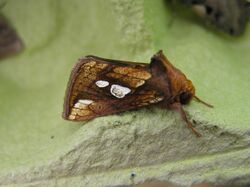Biology:Plusia
From HandWiki
Revision as of 00:43, 21 June 2021 by imported>JTerm (simplify)
Short description: Genus of moths
| Plusia | |
|---|---|

| |
| Plusia festucae | |
| Scientific classification | |
| Domain: | Eukaryota |
| Kingdom: | Animalia |
| Phylum: | Arthropoda |
| Class: | Insecta |
| Order: | Lepidoptera |
| Superfamily: | Noctuoidea |
| Family: | Noctuidae |
| Subtribe: | Plusiina |
| Genus: | Plusia Ochsenheimer, 1816 |
Plusia is a genus of moths of the family Noctuidae. The genus was erected by Ferdinand Ochsenheimer in 1816.
Description
Palpi upturned, where the second joint reaching vertex of head. Antennae of male ciliated. Thorax with a very large spreading tuft on the vertex. Abdomen with three large dorsal tufts on basal segments, and lateral and anal tufts more or less strongly developed in male. Forewings hooked at outer angle. Larva with two pairs of abdominal prolegs.[1]
Species
- Plusia contexta Grote, 1873
- Plusia festucae Linnaeus, 1758 - gold spot
- Plusia magnimacula D. Handfield & L. Handfield, 2006
- Plusia manchurica Lempke, 1966
- Plusia nichollae Hampson, 1913
- Plusia putnami Grote, 1873
- Plusia rosanovi Nabokov, 1912[2]
- Plusia venusta Walker, 1865
References
- Handfield, D.; Handfield, L. (2006). "A new species of Plusia (Lepidoptera: Noctuidae) from North America". The Canadian Entomologist 138 (6): 853–859. doi:10.4039/N06-041.
- Pitkin, Brian; Jenkins, Paul. "Search results Family: Noctuidae". Natural History Museum, London. http://www.nhm.ac.uk/our-science/data/butmoth/search/GenusList3.dsml?&FAMILY=Noctuidae&sort=GENUS.
- Savela, Markku. "Plusia Ochsenheimer, 1816". http://www.nic.funet.fi/pub/sci/bio/life/insecta/lepidoptera/ditrysia/noctuoidea/noctuidae/plusiinae/plusia/.
- ↑ Hampson, G. F. (1894). The Fauna of British India, Including Ceylon and Burma: Moths Volume II. Taylor and Francis. https://www.biodiversitylibrary.org/item/180400#page/5/mode/1up.
- ↑ Writer Vladimir Nabokov paraphrased his father's description of the owlet moth Plusia rosanovi (as it appeared in Volume III of the four-volume Butterflies and Moths of the Russian Empire, 1912) in his posthumous essay "Father's Butterflies", printed in The Atlantic, April 2000: "How lovely it is, by the way, how one's eye is caressed by, the dark-cherry forewing, traversed by a mauve-pink stripe and adorned at its center by the golden emblem of its genus, in this instance a tapering, bowed half-moon -- and if it is hard to render the flowery velvet of the background, what is one to say of the 'emblem,' which, on the actual moth, resembles a dab of gilt redolent of turpentine, and must therefore be copied (and recopied!) in such a way that the painter's work transmits, besides all the rest, a resemblance to the work of a painter!"
Wikidata ☰ Q1375355 entry
 |

